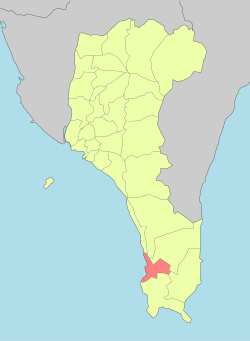This is the current revision of this page, as edited by Cewbot (talk | contribs) at 20:07, 12 July 2024 (Convert Hengchun Peninsula to wikilink (The bot operation is completed 1.7% in total)). The present address (URL) is a permanent link to this version.
Revision as of 20:07, 12 July 2024 by Cewbot (talk | contribs) (Convert Hengchun Peninsula to wikilink (The bot operation is completed 1.7% in total))(diff) ← Previous revision | Latest revision (diff) | Newer revision → (diff) Taiwanese rural township This article is about the township in Pingtung County, Taiwan. Not to be confused with Checheng, Shuili, Nantou County, Taiwan (site of Checheng Station) or Checheng Township in Ji County, Shanxi, China.22°04′47″N 120°44′45″E / 22.079754°N 120.745727°E / 22.079754; 120.745727
Rural township| Checheng Township 車城鄉 Chai-cheng | |
|---|---|
| Rural township | |
 | |
 Checheng Township in Pingtung County Checheng Township in Pingtung County | |
| Location | Pingtung County, Taiwan |
| Area | |
| • Total | 50 km (20 sq mi) |
| Population | |
| • Total | 8,002 |
| • Density | 160/km (410/sq mi) |
| Checheng Township | |
|---|---|
| Traditional Chinese | 車城鄉 |
| Hanyu Pinyin | Chēchéng Xiāng |
| Wade–Giles | Ch'e-ch'eng Hsiang |
| Pha̍k-fa-sṳ | Tshâ-sàng-hiông |
| Hokkien POJ | Chha-siâⁿ-hiong/Chhia-siâⁿ-hiong |

Checheng Township is a rural township in Pingtung County, Taiwan.
Names and etymology
The name of the town. Checheng (Chinese: 車城; pinyin: Chēchéng) combines the Chinese character for "cart", 車 today used to refer to cars and other motorized transport, and 城 which is used in words for walled fortresses and cities, but which in the Taiwanese historical context refers to a town with an earthen security berm.
With the arrival of ethnic Chinese on Taiwan, the native Paiwan name of Kabeyawan was transliterated as Ku-piah-oan (龜壁灣) in the Taiwanese Hokkien language of these new settlers. Following the period of Dutch rule in the 17th century, the name Thóng-léng-po͘ (統領埔; Hakka: Thúng-liâng-phû) was used after Koxinga's son and successor Zheng Jing stationed troops there under a tongling [zh] (統領), a military officer with rank roughly equal to a battalion commander; The suffix po͘ (埔) is often used for place names in Taiwan. A village gradually grew up in the area.

After the Manchu Qing Dynasty assumed control of the lowlands of western Taiwan, ethnic Chinese settlers wanted protection from aboriginal attacks. A wooden palisade was built around the town giving rise to a new name, Chhâ-siâⁿ (柴城; Hakka: Tshài-sàng), using the character 柴 (chhâ) which is the Hokkien word for "wood". Thus Chhâ-siâⁿ has roughly the meaning of "stockade".
In 1788, the fifty-third year of the Qianlong Emperor's rule, Manchu general Fuk'anggan landed his army in the area to suppress the Lin Shuangwen rebellion. In commemoration, the town received yet another name Hok-an-chng (福安庄; also Hok-an-siâⁿ ), with 福 from Fuk'anggan's Chinese name and 安 for "pacified", plus 庄, meaning "hamlet".
The origin of the town's current name Checheng is disputed. Some such as Japanese anthropologist Inō Kanori believe that it arose as a mispronunciation of Chhâ-siâⁿ (柴城); the pronunciations of 柴 and 車 are similar in both Hokkien and Hakka, chhâ/chhia and tshài/tshâ respectively. Another theory is that as an aboriginal army approached the town, the inhabitants used dozens of oxcarts carrying charcoal to lined up as a defense.
Today, Hokkien-speaking inhabitants continue to pronounce the name of the town with the older Chhâ-siâⁿ, though the written form is almost inevitably 車城. English-language maps and sources have historically used spellings such as Chasiang that reflect this pronunciation.
Geography

Area: 49.85 square kilometres (19.25 sq mi)
Population: 8,002 (February 2024)
Administrative divisions
The township comprises 11 villages: Baoli, Fuan, Fuxing, Haikou, Houwan, Puqi, Sheliao, Tianzhong, Tongpu, Wenquan and Xinjie.
Education
Tourist attractions
- Checheng Fu'an Temple
- Kenting National Park
- National Museum of Marine Biology and Aquarium
- Sichongxi Hot Spring
- Dongyuan Forest Recreation Area and Dongyuan Wet Grassland
- Shihmen Ancient battle Field and Mudan Incident Memorial Park
- Syuhai Grassland Recreation Area
- Hsi Chung River Hot Spring
- HaiKou
- Gourmet: Huang's peeled mung bean desert
Notable natives
- Pan Men-an, Magistrate of Pingtung County
References
- 臺灣地區鄉鎮市區級以上行政區域名稱中英對照表 Archived 2012-03-25 at the Wayback Machine Glossary of Names for Administrative Divisions. (in Chinese) Accessed at Taiwan Geographic Names Information System website Archived 2013-08-16 at the Wayback Machine (in English). Ministry of the Interior. 16 June 2011. Retrieved 15 August 2015.
- "Attractions > Hot Spots > Pingtung County > National Museum of Marine Biology and Aquarium >". Archived from the original on 2013-09-21. Retrieved 2012-11-07.
- ^ 《歷史沿革》 at 屏東縣車城鄉公所官方網站 . Archived 2014-02-20 at the Wayback Machine.
External links
- Checheng Township Office, Pingtung County Government (in Chinese)
- Checheng Township Travel Guide (in English)
| Cities and townships of Pingtung County | ||
|---|---|---|
| County seat: Pingtung City | ||
| Cities |  | |
| Urban townships | ||
| Rural townships | ||
| Mountain indigenous townships | ||
| Townships in Taiwan | |||||||||||||||||||||||||||
|---|---|---|---|---|---|---|---|---|---|---|---|---|---|---|---|---|---|---|---|---|---|---|---|---|---|---|---|
| Urban townships |
| ||||||||||||||||||||||||||
| Rural townships |
| ||||||||||||||||||||||||||
| Mountain indigenous townships |
| ||||||||||||||||||||||||||
| Note: Pinyin is the national standard and promulgated by the Ministry of Interior. Exceptions: "Lukang" instead of "Lugang" and names of Counties. | |||||||||||||||||||||||||||
This article about a location in Taiwan is a stub. You can help Misplaced Pages by expanding it. |